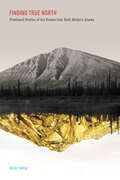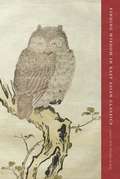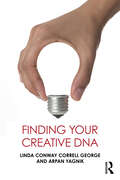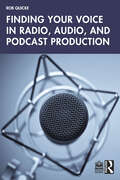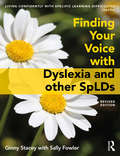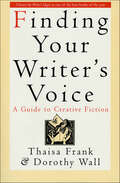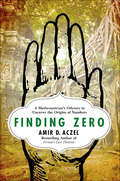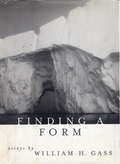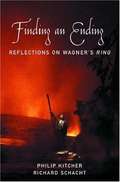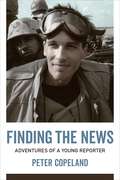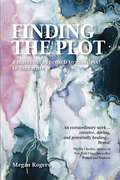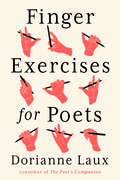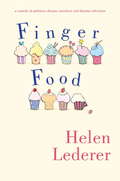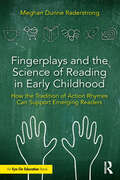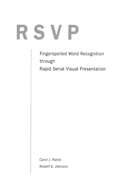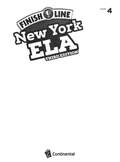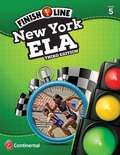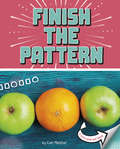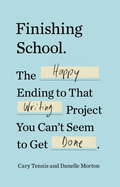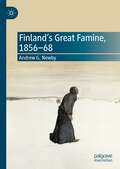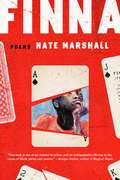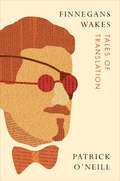- Table View
- List View
Finding Solutions for Protecting and Sharing Archaeological Heritage Resources
by Anne P. Underhill Lucy C. SalazarThis volume provides case studies about successful strategies employed in diverse world areas for the protection of archaeological heritage resources. Some chapters focus on a search for solutions arrived at by diverse groups of people working in specific areas rather than simply describing loss of cultural heritage. Other chapters provide a long-term view of intensified efforts at protection of archaeological resources. The authors describe challenges and solutions derived by concerned people in eastern Asia (China, Japan, Thailand), West Africa, Easter Island, Jordan, Honduras and more than one area of Peru. All of the authors draw upon deep, personal involvement with the protection of cultural heritage in each area. This volume is a timely addition to a growing number of conferences and publications about the management of cultural heritage--both archaeological and historical.
Finding True North: First-Hand Stories of the Booms that Built Modern Alaska
by Molly RettigMelting sea ice and rumbling volcanoes. Sled dogs racing through unnamed valleys. These were the images that came to mind when Molly Rettig moved to Fairbanks, Alaska to work as a reporter at the local newspaper. An avid environmentalist, she couldn’t wait to explore the vast, untamed spaces that had largely been paved over on the east coast. But when her 72-year-old neighbor, Clutch, invites her on a tour of his gold mine—an 800-foot tunnel blasted into the side of his house–she begins to question many of her ideas about Alaska, and about herself. In Finding True North, Rettig takes us on a gripping journey through Alaska's past that brings alive the state's magnificent country and its quirky, larger-than-life characters. She meets a trapper who harvests all she needs from the land, a bush pilot who taught himself how to fly, and an archaeologist who helped build an oil pipeline through pristine wilderness. While she learns how airplanes, mines, and oil fields have paved the way for newcomers like herself, she also stumbles upon a bigger question: what has this quest for Alaska’s natural resources actually cost, and how much more is at stake? This is a book about all the ways wild places teach us about ourselves. Rettig writes both playfully and honestly about how one place can be many things to many people—and how all of it can be true.
Finding Wisdom in East Asian Classics
by Ed. De Bary Wm. TheodoreFinding Wisdom in East Asian Classics is an essential, all-access guide to the core texts of East Asian civilization and culture. Essays address frequently read, foundational texts in Chinese, Japanese, Korean, and Vietnamese, as well as early modern fictional classics and nonfiction works of the seventeenth century. Building strong links between these writings and the critical traditions of Confucianism, Buddhism, and Daoism, this volume shows the vital role of the classics in the shaping of Asian history and in the development of the humanities at large.Wm. Theodore de Bary focuses on texts that have survived for centuries, if not millennia, through avid questioning and contestation. Recognized as perennial reflections on life and society, these works represent diverse historical periods and cultures and include the Analects of Confucius, Mencius, Laozi, Xunxi, the Lotus Sutra, Tang poetry, the Pillow Book, The Tale of Genji, and the writings of Chikamatsu and Kaibara Ekken. Contributors explain the core and most commonly understood aspects of these works and how they operate within their traditions. They trace their reach and reinvention throughout history and their ongoing relevance in modern life. With fresh interpretations of familiar readings, these essays inspire renewed appreciation and examination. In the case of some classics open to multiple interpretations, de Bary chooses two complementary essays from different contributors. Expanding on debates concerning the challenges of teaching classics in the twenty-first century, several pieces speak to the value of Asia in the core curriculum. Indispensable for early scholarship on Asia and the evolution of global civilization, Finding Wisdom in East Asian Classics helps one master the major texts of human thought.
Finding Your Creative DNA
by Arpan Yagnik Linda Conway Correll GeorgeThis book enables readers to discover their inner creative DNA, by providing a strong dose of the four elements of the Creative Matrix–Interrogation, Information, Interpretation, and Inspiration. Creative Aerobics (CA) generates a personal ideation system that produces creativity on demand (COD) and that arrives at multiple solutions in less than an hour in a relaxing and enjoyable way.The strength of the volume lies in its ability to move readers past the conventional and time-consuming 20th-century ideation. It helps develop an individual, personal approach to their creative DNA by introducing increasingly complex word exercises that strengthen left-brain problem-solving and increase right-brain discoveries. It teaches, encourages, and integrates all aspects of CA to develop the mental muscle that fuels readers’ paths to creative accomplishment. By taking CA step by step, readers develop a comfort level, knowing they will always be able to come up with ideas.This book will be useful to students, young professionals, and senior leaders looking for the inside track to their creativity. It will also be an invaluable daily practice and interesting read for all students taking general education courses, especially those opting for integrative learning courses which are becoming more prevalent across universities worldwide.
Finding Your Voice in Radio, Audio, and Podcast Production
by Rob QuickeThis book provides a unique identity-centered approach to radio, audio, and podcast production which encourages readers to build their confidence and create audio content that matters to them. Written for those just starting out in audio production and focusing on the process of their self-development, readers will learn how to use sound to express themselves in a variety of ways and to create powerful stories in the process – all with the tools already available to them. At the centre of this approach is the author’s R.E.A.L. method, referring to the creation of audio that is relatable, engaging, authentic, and liberating. Students will learn to apply this concept to each step of the production process, from planning and writing through to interviewing, broadcasting, and responding to feedback. By the end of this book readers will have developed a working knowledge of podcast, audio, and radio production alongside their own means of self-expression. Supported by exercises and interviews with audio practitioners throughout, Finding Your Voice in Radio, Audio, and Podcast Production is a key resource for anyone approaching radio, audio, or podcasting for the first time. A supporting companion website with Instructor and Student Resources is available at www.robquicke.com.
Finding Your Voice with Dyslexia and other SpLDs
by Ginny Stacey Sally FowlerFinding Your Voice with Dyslexia and other SpLDs is an essential guide to living with dyslexia and other specific learning difficulties (SpLDs). The book provides readers with a practical guide to expressing and developing ideas and feelings. Uniquely designed for dyslexic/ SpLD readers, this book discusses how individual people function and will help readers to: •understand how they think•know what they can do to maintain clear thinking•know how they can positively contribute to any situation in which they find themselves.When people with SpLD find their voice, they gain the self-esteem and confidence to tackle all elements of life (study, employment, general living) and to negotiate sucessfully with those around them. The book contains stories, insights, examples, tips and exercises, presented in a user-friendly way throughout. The book has also been designed for non-linear reading and each chapter includes a ‘dipping-in’ section to guide the reader. The book does not have to be read as solid, continuous text from start to finish: it can be read more like a travel guide.As well as providing vital assistance to people with dyslexia and other specific learning difficulties, this book will benefit anyone supporting, living or working with dyslexic/ SpLD people by helping them to understand more about the dyslexic/ SpLD world.
Finding Your Writer's Voice: A Guide to Creative Fiction
by Thaisa Frank Dorothy WallAn illuminating guide to finding one's most powerful writing tool, Finding Your Writer's Voice helps writers learn to hear the voices that are uniquely their own. Mixing creative inspiration with practical advice about craft, the book includes chapters on:Accessing raw voiceListening to voices of childhood, public and private voices, and colloquial voicesWorking in first and third person: discovering a narrative personaUsing voice to create charactersShaping one's voice into the form of a storyReigniting the energy of voice during revision
Finding Zero: A Mathematician's Odyssey to Uncover the Origins of Numbers
by Amir D. Aczel“A captivating story, not just an intellectual quest but a personal one . . . gripping [and] filled with the passion and wonder of numbers.” —The New York TimesVirtually everything in our lives is digital, numerical, or quantified. But the story of how and where we got these numerals, which we so depend on, has for thousands of years been shrouded in mystery. Finding Zero is the saga of Amir Aczel’s lifelong obsession: to find the original sources of our numerals, perhaps the greatest abstraction the human mind has ever created.Aczel has doggedly crisscrossed the ancient world, scouring dusty, moldy texts, cross-examining so-called scholars who offered wildly differing sets of facts, and ultimately penetrating deep into a Cambodian jungle to find a definitive proof. Here, he takes the reader along for the ride.The history begins with Babylonian cuneiform numbers, followed by Greek and Roman letter numerals. Then Aczel asks: Where do the numbers we use today, the so-called Hindu-Arabic numerals, come from? It is this search that leads him to explore uncharted territory on a grand quest into India, Thailand, Laos, Vietnam, and ultimately into the wilds of Cambodia. There he is blown away to find the earliest zero—the keystone of our entire system of numbers—on a crumbling, vine-covered wall of a seventh-century temple adorned with eaten-away erotic sculptures.While on this odyssey, Aczel meets a host of fascinating characters: academics in search of truth, jungle trekkers looking for adventure, surprisingly honest politicians, shameless smugglers, and treacherous archaeological thieves—who finally reveal where our numbers come from.“A historical adventure that doubles as a surprisingly engaging math lesson . . . rip-roaring exploits and escapades.” —Publishers Weekly
Finding a Form
by William H. GassFrom the author of The Tunnel comes a new collection of essays, his first in eight years, on art, writing, nature and culture. This book is by one of the most important and briliant thinkers at work today.
Finding an Ending: Reflections on Wagner's Ring
by Philip Kitcher Richard SchachtFew musical works loom as large in Western culture as Richard Wagner's four-partRing of the Nibelung. InFinding an Ending, two eminent philosophers, Philip Kitcher and Richard Schacht, offer an illuminating look at this greatest of Wagner's achievements, focusing on its far-reaching and subtle exploration of problems of meanings and endings in this life and world. Kitcher and Schacht plunge the reader into the heart of Wagner'sRing, drawing out the philosophical and human significance of the text and the music. They show how different forms of love, freedom, heroism, authority, and judgment are explored and tested as it unfolds. As they journey across its sweeping musical-dramatic landscape, Kitcher and Schacht lead us to the central concern of the Ring--the problem of endowing life with genuine significance that can be enhanced rather than negated by its ending, if the right sort of ending can be found. The drama originates in Wotan's quest for a transformation of the primordial state of things into a world in which life can be lived more meaningfully. The authors trace the evolution of Wotan's efforts, the intricate problems he confronts, and his failures and defeats. But while the problem Wotan poses for himself proves to be insoluble as he conceives of it, they suggest that his very efforts and failures set the stage for the transformation of his problem, and for the only sort of resolution of it that may be humanly possible--to which it is not Siegfried but rather Br nnhilde who shows the way. TheRing's ending, with its passing of the gods above and destruction of the world below, might seem to be devastating; but Kitcher and Schacht see a kind of meaning in and through the ending revealed to us that is profoundly affirmative, and that has perhaps never been so powerfully and so beautifully expressed. At the end of the book is a very detailed synopsis of all four operas.
Finding the News: Adventures of a Young Reporter
by Peter CopelandFinding the News tells Peter Copeland’s fast-paced story of becoming a distinguished journalist. Starting in Chicago as a night police reporter, Copeland went on to work as a war correspondent in Latin America, the Middle East, and Africa before covering national politics in Washington, DC, where he rose to be bureau chief of the E. W. Scripps Company. The lessons he learned about accuracy and fairness during his long career are especially relevant today, given widespread concerns about the performance of the media, potential bias, and the proliferation of so-called “fake news.” He offers an honest and revealing narrative, told with surprising humor, about how he learned the craft of news reporting.Copeland’s story begins in 1980, when a colleague hastily declared him a full-fledged reporter after barely four days of training. He went on to learn the business the old-fashioned way: by chasing the news in thirty countries and across five continents. As a young person entering journalism and reporting during some of recent history’s most fraught military situations— including Operation Desert Storm and the US invasions of Panama and Somalia—Copeland discovered the craft was his calling. Looking back on his career, Copeland asserts his most important lessons were not about reporting, writing, or the latest technologies, but about the core values that underlie quality journalism: accuracy, fairness, and speed. Replete with behind-the-scenes stories about learning the trade, Copeland’s inspiring account builds into a heartfelt defense of journalism “done the right way” and serves as a call to action for today’s reporters. The values he learned as a cub reporter are needed now more than ever, he argues, as the integrity and motives of even seasoned journalists are called into question by political partisans. Copeland admits that those critics are not entirely wrong but contends that exciting new technologies, combined with a return to old-school news values, could usher in a golden age of journalism.
Finding the Words: Writers on Inspiration, Desire, War, Celebrity, Exile, and Breaking the Rules
by Jared BlandCelebrated writers reveal surprising truths about the joys, challenges, and importance of finding the words, in this special fundraising anthology for PEN Canada. In Finding the Words, thirty-one well-known writers share deeply personal discoveries and stories that will surprise, delight, and stir the mind and heart. By turns inspiring, provocative, witty, and compelling, these diverse and original pieces explore home, exile, and the search for a place to belong; community, creativity, celebrity, and the many forms power can take. Among the pieces in the anthology: Diana Athill and Alice Munro discuss the consequences of writing about other people; Gord Downie meditates on what it means to be a songwriter by considering one of his own songwriting heroes; Guy Gavriel Kay reflects on how his relationship with his own readers continues to change; Elizabeth Hay searches for inspiration in the fallow period between books; Rawi Hage meditates on writing rooted in the universal experience of exile; Pasha Malla and Moez Surani present a funny and confounding list of "rules for writers" solicited from non-writers; Heather O'Neill tells the story of an illiterate and underage wannabe gangster in mid-century Montreal; Michael Winter pieces together court transcripts, newspaper accounts, and other primary sources to take us into the dark heart of a real-life Newfoundland crime story. Proceeds from this volume will go to PEN Canada in support of its vital work in defence of freedom of expression and on behalf of writers around the world who have been silenced. Finding the Words Contributors List:Diana AthillTash AwDavid Bezmozgis Joseph Boyden David Chariandy Denise ChongKaren Connelly Alain de Botton Emma Donoghue Gord Downie Marina Endicott Stacey May Fowles Rawi Hage Elizabeth Hay Steven Heighton Lee Henderson Guy Gavriel Kay Mark Kingwell Martha Kuwee Kumsa Annabel Lyon Linden MacIntyre Pasha Malla Lisa Moore Alice Munro Stephanie Nolen Heather O'Neill Richard Poplak Moez Surani Miguel Syjuco Madeleine Thien Michael Winter With cover design and illustration by Sethwww.pencanada.caFrom the Trade Paperback edition.
Finding the plot: A Maternal Approach to Madness in Literature
by Megan RigersOver the past fifty years, feminist literary criticism has become theoretical rather than practical, severing any relationship between literary analysis and the real lived experiences of women. An example of this disconnect is the way in which the madwoman in feminist literature has become a lauded icon of liberation, when in reality her situation would be seen as anything but empowered. Finding the Plot takes this example to task, arguing that in fact any interpretation of women’s madness as subversive reinforces the very gender stereotypes that feminist literary criticism should be calling into question.
Finger Exercises for Poets
by Dorianne LauxAn illuminating book of concise craft essays and exercises for poets, from Pulitzer Prize finalist and The Poet’s Companion coauthor Dorianne Laux. From “a poet of immense insight and masterful craft” (Kwame Dawes), Finger Exercises for Poets is an engaging and inspiriting invitation to practice poetry alongside one of its masters. With wide-ranging examples from classic and contemporary poets, Dorianne Laux demystifies the magic of language that makes great poetry and offers generative exercises to harness that magic. She explores the syllable and the line, the use of form, poetic responses to contemporary events and personal experiences, the imaginative leap, and the power of a distinct voice. As she writes in the introduction, “My instrument is the immensity of language.… There are eighty-eight keys on a piano, six hundred thousand words in the English language. The patterns, sequences, and permutations of both are endless. For me, language is another kind of music.… I practice poetry. This book invites you to practice along with me.” Throughout, Laux reminds us that poetry is a practice as much as an art and that poets must hone their language as a musician practicing an instrument.
Finger Food
by Helen LedererBella le Pard’s career as a TV presenter is ‘on hold’. To fill her days, she sits in a coffee shop and obsesses about a wedding dress in the neighbouring shop. Her luck changes when she gets the call from her old boss at ‘Flair for living TV’ to present a pilot for a new food and chat show. But her revived TV career is short-lived when one of the celebrity guests threatens to steal the show. Bella finds herself turning to blackmail to save her job. But will her threat to reveal her boss’s infidelity keep her on TV? And will she ever find a reason to buy that dream wedding dress?
Fingerplays and the Science of Reading in Early Childhood: How the Tradition of Action Rhymes Can Support Emerging Readers
by Meghan Dunne RaderstrongUnlock the magic of fingerplays and transform your early childhood classroom with this essential guide bridging research and practice.While many books compile fingerplays and action rhymes, few explore their rich history or the science behind their impact on early literacy and social development. This groundbreaking guide offers teachers and caregivers a resource that connects tradition with evidence-based practices, examining how fingerplays align with the latest research in the science of reading and offering insights into their effectiveness.Featuring a wealth of research on early literacy and social development, the book includes a practical section filled with selected rhymes and visual cues for easy classroom implementation. Fingerplays and the Science of Reading in Early Childhood is a timeless addition to any early childhood educator’s collection.
Fingerspelled Word Recognition through Rapid Serial Visual Presentation
by Carol J. Patrie and Robert E. JohnsonRSVP can be used in the classroom or for self-study. Learning and practicing this extensively researched approach is the key to unlocking the mystery of understanding fingerspelling. [Carol J. Patrie, Robert E. Johnson; (2011) Book: 185 pages; soft cover; coil bound, CD-ROM, DVD: 187 minutes; no audio; Mac OS X 10.6; PC Windows 7] Item not returnable once opened. The book explains the form and function for the types of fingerspelling: careful, rapid and lexicalized.
Finish Line New York ELA: Grade 4
by Continental Press StaffFinish Line New York ELA Third Edition Grade 4
Finish Line New York ELA: Grade 5 (Third Edition)
by Continental Press StaffNeed more standards support in your lesson plans? Finish Line New York ELA is the perfect fit with step-by-step instruction to help students take on the challenging nature of New York's Common Core Learning Standards (CCLS). This next generation of Finish Line includes 300+ pages of focused practice and a new lesson format. The gradual release model is extended to four parts to promote deeper learning: Skill Introduction, Focused Instruction, Guided Practice, and Independent Practice. Guided questions model the thought process. Language Arts/Writing is integrated into the book. A full unit of writing standards helps students practice the writing process, learn how to answer open-ended questions, and apply grammar and usage conventions. Much like New York's standards and assessments, students are required to do close reading of rigorous text. Reviews include PARCC-type items, as well as multiple-choice, open-ended, and multipart questions. Finish Line is designed to supplement core basal programs, including ReadyGEN(tm) and Common Core Code X(tm).
Finish the Pattern: A Turn-and-See Book (What's Next?)
by Cari MeisterFrom the days of the week to playing hopscotch, patterns are all around you. Keep turning the pages to find out how your life is full of patterns and sequences.
Finishing School: The Happy Ending to That Writing Project You Can't Seem to Get Done
by Danelle Morton Cary TennisAll too many people start a writing project with grand ambitions but reach a crisis of completion. Finishing School helps writers reignite the passion that started them on the project in the first place and work steadily to get it done. Untold millions of writing projects—begun with hope and a little bit of hubris—lie abandoned in desk drawers, in dated files on computer desktops, and in the far reaches of the mind. Too often, writers get tangled in self-abuse—their self-doubt, shame, yearning for perfection, and even arrogance get in the way. In Finishing School, Cary Tennis and Danelle Morton help writers overcome these emotional blocks and break down daunting projects into manageable pieces. Tennis first convened a Finishing School so that writers could help one another stay on track and complete their work. Since they weren’t actually critiquing one another’s writing, there was no jockeying for the title of best writer or the usual writing group politics; there was only a shared commitment to progress. Without guilt, blame, and outside critique, students were more productive than they imagined possible. Through this program, they were able to complete novels that they’d been struggling with for almost two decades, finish screenplays drafts, and revive interest in long-neglected PhD theses. In this book, the authors share this proven and easily replicable technique, as well as their own writing success stories.From the Trade Paperback edition.
Finite-State Computational Morphology: An Analyzer and Generator for Georgian
by Irina LobzhanidzeThis handbook provides a comprehensive account of current research on the finite-state morphology of Georgian and enables the reader to enter quickly into Georgian morphosyntax and its computational processing. It combines linguistic analysis with application of finite-state technology to processing of the language. The book opens with the author’s synoptic overview of the main lines of research, covers the properties of the word and its components, then moves up to the description of Georgian morphosyntax and the morphological analyzer and generator of Georgian.The book comprises three chapters and accompanying appendices. The aim of the first chapter is to describe the morphosyntactic structure of Georgian, focusing on differences between Old and Modern Georgian. The second chapter focuses on the application of finite-state technology to the processing of Georgian and on the compilation of a tokenizer, a morphological analyzer and a generator for Georgian. The third chapter discusses the testing and evaluation of the analyzer’s output and the compilation of the Georgian Language Corpus (GLC), which is now accessible online and freely available to the research community.Since the development of the analyzer, the field of computational linguistics has advanced in several ways, but the majority of new approaches to language processing has not been tested on Georgian. So, the organization of the book makes it easier to handle new developments from both a theoretical and practical viewpoint.The book includes a detailed index and references as well as the full list of morphosyntactic tags. It will be of interest and practical use to a wide range of linguists and advanced students interested in Georgian morphosyntax generally as well as to researchers working in the field of computational linguistics and focusing on how languages with complicated morphosyntax can be handled through finite-state approaches.
Finland’s Great Famine, 1856-68
by Andrew G. NewbyThis book will provide a thematic overview of one of European history’s most devastating famines, the Great Finnish Famine of the 1860s. In 1868, the nadir of several years of worsening economic conditions, 137,000 people (approximately 8% of the Finnish population) perished as the result of hunger and disease. The attitudes and policies enacted by Finland’s devolved administration tended to follow European norms, and therefore were often similar to the “colonial” practices seen in other famines at the time. What is distinctive about this catastrophe in a mid-nineteenth-century context, is that despite Finland being a part of the Russian Empire, it was largely responsible for its own governance, and indeed was developing its economic, political and cultural autonomy at the time of the famine. Finland’s Great Famine 1856-68 examines key themes such as the use of emergency foods, domestic and overseas charity, vagrancy and crime, emergency relief works, and emigration.
Finna: Poems
by Nate MarshallSharp, lyrical poems celebrating the Black vernacular—its influence on pop culture, its necessity for familial survival, its rite in storytelling and in creating the safety found only within its intimacyDefinition of finna, created by the author: fin·na /ˈfinə/ contraction: (1) going to; intending to [rooted in African American Vernacular English] (2) eye dialect spelling of &“fixing to&” (3) Black possibility; Black futurity; Blackness as tomorrowThese poems consider the brevity and disposability of Black lives and other oppressed people in our current era of emboldened white supremacy, and the use of the Black vernacular in America&’s vast reserve of racial and gendered epithets. Finna explores the erasure of peoples in the American narrative; asks how gendered language can provoke violence; and finally, how the Black vernacular, expands our notions of possibility, giving us a new language of hope:nothing about our people is romantic& it shouldn&’t be. our people deservepoetry without meter. we deserve ourown jagged rhythm & our own unevenwalk towards sun. you make happening happen.we happen to love. this is our greatestaction.
Finnegans Wakes: Tales of Translation
by Patrick O'NeillJames Joyce's astonishing final text, Finnegans Wake (1939), is universally acknowledged to be entirely untranslatable. And yet, no fewer than fifteen complete renderings of the 628-page text exist to date, in twelve different languages altogether – and at least ten further complete renderings have been announced as underway for publication in the early 2020s, in nine different languages. Finnegans Wakes delineates, for the first time in any language, the international history of these renderings and discusses the multiple issues faced by translators. The book also comments on partial and fragmentary renderings from some thirty languages altogether, including such perhaps unexpected languages as Galician, Guarani, Chinese, Korean, Turkish, and Irish, not to mention Latin and Ancient Egyptian. Excerpts from individual renderings are analysed in detail, together with brief biographical notes on numerous individual translators. Chronicling renderings spanning multiple decades, Finnegans Wakes illustrates the capacity of Joyce's final text to generate an inexhaustible multiplicity of possible meanings among the ever-increasing number of its impossible translations.

